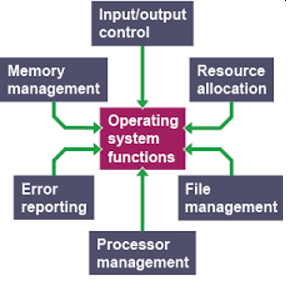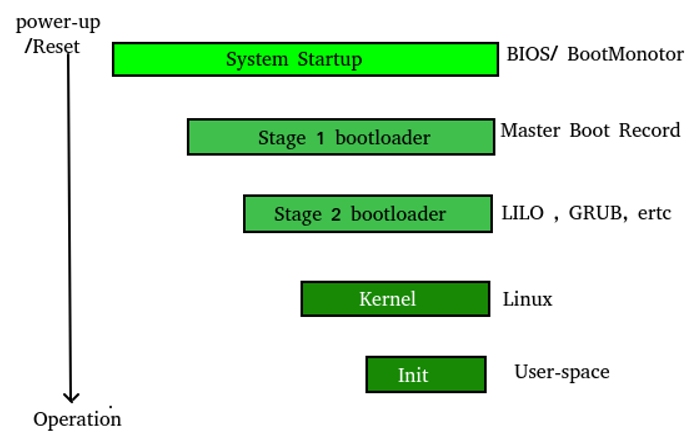Operating Systems
Table of contents
Introduction to OS
First thing a computer has to do when it is turned on, is start up a special program called an operating system.
OS’s job - To help other computer programs to work by handling the details of controlling the computer’s hardware.
Computer Systems
- Hardware – cpu, memory, io-devices
- Softwares
- System Softwares – OS, Compiler, Loader.
- Application Software – email, ms-office, games, railway reservation system.
- Users – people, computer
Operating system is an interface between user and hardware.
Responsibilities of OS:
- Provide an environment in which user can execute programs.
- Resource allocator
- Manager – Memory, processes, files, security etc.

Goals of OS:
- Primary - convenience
- Secondary - efficiency
System Boot Step Sequence

System and Application Programs
Computer Hardware
Operating System
User 1
User 2
User 3
Data Types – Defines the Type of data and operations allowed on it.
Types of Operating Systems

Batch OS
- Jobs with similar needs batched together, run as a group.
- First come first served.
Disadvantages
- Only after completion of job1, control is transferred to job2.
- Under-utilisation of resources.
- Lack of interaction between user and program.
Multitasking OS
- Jobs should be executed in time sharing mode.
- Fixed time quantum to every job (Preemption).
Topics
Introduction to OS
- Introduction to OS
- Types of OS
- Services and Examples
- Types of OS
- Single Tasking
- Multiprogramming and Multitasking
- Multithreading
- Real-world examples
- Disadvantages
- Examples of Race Condition
- Multiprocessing
- Multiuser
- Thread V/S Process
- User Threads V/S Kernel Threads
Process Management
- Introduction to Program and Process
- Process States
- For Single Tasking Systems.
- Multiprogramming Systems
- 5-States Model
- 7-States Model
- Process Control Block(PCB)
- Process Scheduler
- Long Term Scheduler
- Short Term Scheduler
- Medium Term Scheduler
- Scheduling Algorithms
- Background
- Explaining various times in Scheduling algorithms
- Goals of Scheduling Algorithms
- FCFS Algorithm (Non-Preemptive)
- Understanding using a problem
- Calculating various times
- Characteristics of FCFS Algo
- SJFS Algorithm (Non-Preemptive)
- Understanding using a problem
- Calculating various times
- Characteristics of SJFS Algo
- SJF or SRTF Algorithm(Pre-emptive)
- Understanding using a problem
- Calculating various times
- Characteristics of SJF or SRTF Algo
- Priority Scheduling (Non-Preemptive)
- Understanding using a problem
- Calculating various times
- Priority Scheduling (Preemptive)
- Understanding using a problem
- Calculating various times
- Problems with Priority Scheduling
- Round Robin Scheduling (Pre-emptive)
- Characteristic
- Calculating various times using a problem
- Multilevel Queue Scheduling
- Multilevel Queue Scheduling with Feedback
Process Synchronization
- Introduction
- Consumer and Producer Problem
- Race Condition
- Goals of Synchronization Mechanism
- Mutual Exclusion
- Progress
- Bounded Waiting
- Performance
- Overview of Synchronization Mechanism
- Disabling Interrupts
- Locks(or Mutex)
- Semaphores
- Monitors
- Application of Process Synchronization
- Locks for Synchronization
- Problems of Deposit and Withdrawl problem
- TSL Lock mechanism
- Critical Section
- Problems of Deposit and Withdrawl problem
- Entry Section
- Critical Section
- Exit Section
- Non-Critical Section
- Semaphores
- wait() and signal() function
- Original importance by Dijkstra
- Binary Semaphore
- Internal Working of Semaphore
- Binary Semaphore
- Wait and Signal Protocol in Binary Semaphore
- Monitors
- Introduction, Syntax and Working
Deadlock
- Introduction and Understanding
- Mutual Exclusion
- Hold and Wait
- No Preemption
- Circular Wait
- Resource Allocation Graph
- Deadlock Handling Mechanism
- Deadlock Prevention
- Deadlock Avoidance
- Detection and Recovery
- Ignoring the Deadlock
- EDEADLK
- Deadlock Prevention Mechanism
- Mutual Exclusion
- Hold and Wait
- No Preemption
- Circular Wait
- Deadlock Avoidance Mechanism
- Bankers Algorithm
- Discussion on Deadlock Detection and Recovery
Memory Management
- Working behind the compilation and running of a program
- Address Binding
- Compile Time
- Load Time
- Run Time
- Problems of Runtime Binding
- Logical and Physical Address
- Runtime Binding
- Working
- Memory Management and hierarchy
- Access time, capacity and cost
- Evolution of Memory Management
- Single Tasking
- Multitasking
- Memory Allocation
- Dynamic Partitioning
- Bitmap
- Linked List
- Virtual Memory Introduction
- Concept discussion
- Performance Impact of Page Fault
- TLB, Demand Paging, Thrashing, Page Replacement Algorithm
- Segmentation and Paging with Segmentation